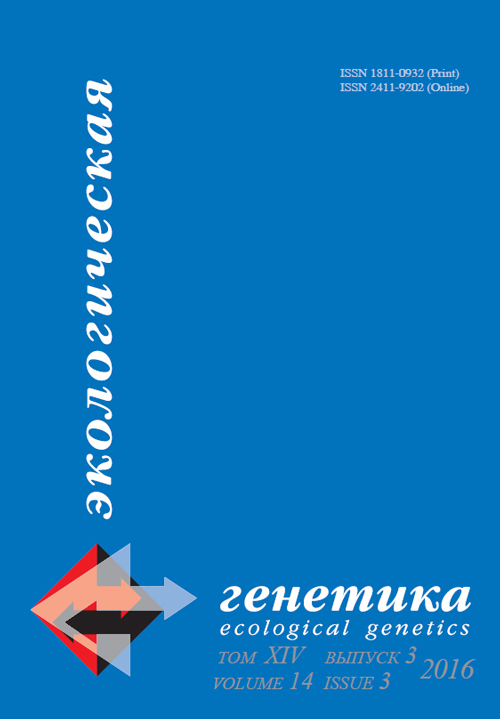Том 14, № 3 (2016)
- Год: 2016
- Выпуск опубликован: 15.09.2016
- Статей: 6
- URL: https://journals.eco-vector.com/ecolgenet/issue/view/309
- DOI: https://doi.org/10.17816/ecogen143
Статьи
О биологическом и социальном в сексуальной ориентации человека: хемокоммуникационная гипотеза
Аннотация
Недопонимание роли биологических и социальных факторов в формировании некоторых социально значимых признаков у человека могут приводить к возникновению неоправданной напряженности в межличностных отношениях. Это связано с частой недостоверностью информации, ее искаженным восприятием, размытостью из-за нечеткости используемой терминологии и, как следствие, невозможности ее корректного анализа воспринимающим человеком. На примере признака «сексуальная ориентация» показано, как генетические представления о формировании признака и данные о механизмах контроля формирования пола могут уточнить и дополнить наши знания по этому вопросу. В рамках темы рассмотрена гипотеза о хемокоммуникационной модели формирования «сексуальной ориентации» у человека.
 3-12
3-12


Генетическая структура популяций особо охраняемого моллюска Cepaea vindobonensis (Mollusca, Gastropoda, Pulmonata) в условиях северо-восточной части современного ареала
Аннотация
С использованием аллозимов и ДНК-маркеров было проведено исследование популяционной структуры реликтового и особо охраняемого вида Cepaea vindobonensis Fer. (Mollusca, Gastropoda, Pulmonata) в условиях северо-восточной части современного ареала. Выявлены группы как с высоким, так и с низким уровнем генетического разнообразия. Отмечена высокая степень дифференциации изучаемых популяций (Fst = 0,231, Gst = 0,265, Фst = 0,261–0,263, Nm = 0,630–0,832), что говорит о нарушении каналов миграции и длительной изоляции их друг от друга. Расчет эффективной численности и сопоставление ее с аналогичными показателями фоновых и уязвимых видов наземных моллюсков продемонстрировали высокий уровень жизнеспособности популяций C. vindobonensis в районе исследования.
 13-27
13-27


Ассоциация уровня общего содержания каротиноидов в зерне кукурузы (Zea mays L.) с аллельным полиморфизмом сайта InDel1 гена PSY1
Аннотация
Кукуруза — единственная из основных зерновых культур, способная накапливать значительное количество каротиноидов, которые являются предшественниками провитамина А. Проведена оценка ассоциации уровня содержания каротиноидов в зерне кукурузы с аллельным полиморфизмом PSY1 InDel1. В работе использовали коллекцию из 54 генотипов кукурузы различного эколого-географического происхождения, методы ПЦР-анализа, спектрофотометрии, статистический анализ. Показано, что в эндосперме генотипов, несущих благоприятный аллель InDel1, содержание каротиноидов в среднем составило 0,60 мг/100 г, что достоверно выше, чем у образцов с неблагоприятным аллелем (0,43 мг/100 г). Таким образом, использование ПЦР-маркеров к полиморфизму PSY1 InDel1 является надежным методом идентификации перспективных генотипов кукурузы с высоким уровнем накопления каротиноидов в зерне.
 28-34
28-34


О подходах к изучению микроэволюционных явлений в природных популяциях хирономид. неравновесность популяций как стабильное состояние
Аннотация
 35-46
35-46


Морфологические и генетические особенности ряпушки (coregonidae: coregonus sp.) озера Собачье (плато Путорана)
Аннотация
Анализ особенностей морфологии и полиморфизма митохондриальной ДНК (мтДНК) ряпушки (Coregonus sp.) оз. Собачье (плато Путорана) показал значительную близость этой популяции ряпушке европейских водоемов — Coregonus albula (Linnaeus). Полученные данные позволяют обсуждать ряд гипотез о происхождении собачинской ряпушки и ее филогенетических взаимоотношениях с ряпушкой Европы и Сибири.
 47-55
47-55


Транскрипционная активность генов, участвующих в регуляции диапаузы колорадского жука, и ее изменения под влиянием инсектицида фипронила
Аннотация
Исследованы особенности транскрипционной активности генов, принимающих участие в регуляции диапаузы у имаго колорадского жука в лабораторных условиях, на стадии подготовки к зимней диапаузе и в середине зимнего периода. В гонадах остающихся активными особей, в отличие от особей, находящихся в состоянии покоя, установлено наличие мРНК гена субъединицыrdl рецептора GABA-А. Выявлено повышение содержания мРНК генов DP1, fer, DAT1, DAT2, EcR, Ldace-1 в середине периода зимней диапаузы в тканях мышц и гонад особей, перенесших действие фипронила, неконкурентного ингибитора ионотропного канала, образованного рецептором GABA-A. Выдвинуто предположение о том, что фипронил, блокируя связывание GABA с рецептором, тем самым оказывает существенное влияние на регуляторные процессы, сопровождающие развитие диапаузных состояний.
 56-63
56-63












